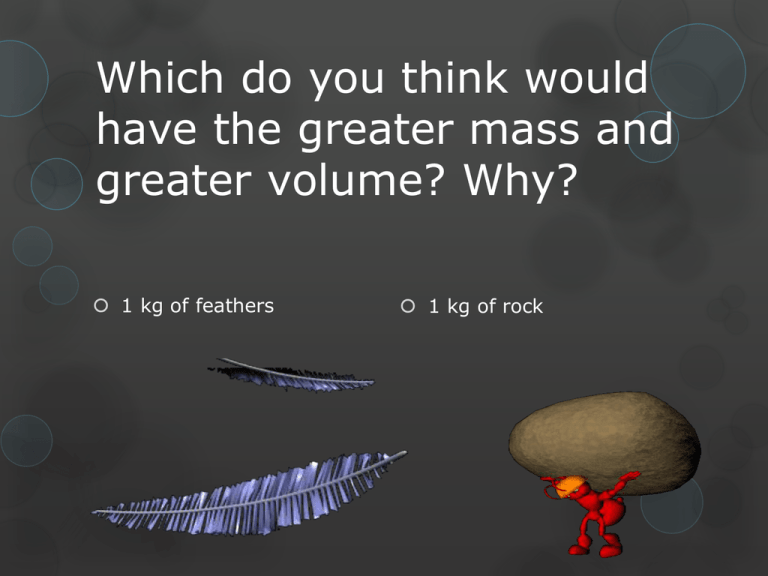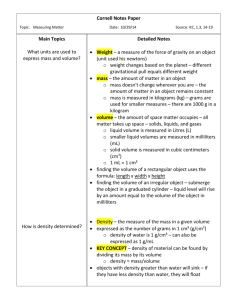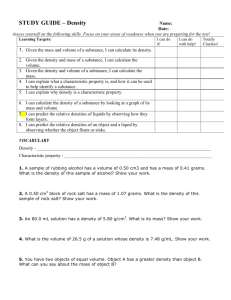File
advertisement

Which do you think would have the greater mass and greater volume? Why? 1 kg of feathers 1 kg of rock Anything that doesn't matter has no mass. Matter is any substance which: 1.Has mass 2.Occupies space (i.e. has volume) Volume – amount of space an object takes up Indirectly Mass is the amount of Matter in an object Weight is the gravitational force acting on an object o o o o Grams (g) Kilograms (kg) 1 kg = 1000 g, kilo means thousand 0.001 kg = 1 g o To convert grams to kilograms, divide the number of grams by 1000 o To convert kilograms to grams, multiply the number of kilograms by 1000 To find the density 1- Find the mass of the object 2- Find the volume of the object 3- Divide Density = Mass_ Volume Density is just the amount of matter within a certain volume. To find density: 1) Find the mass of the object 2) Find the volume of the object 3) Mass Divided by Volume Ex. If the mass of a liquid is 35 grams and it takes up 7 mL of space, calculate the density. D= 𝑀 𝑉 = 35 𝑔 7 𝑚𝐿 = 5𝑔 𝑚𝐿 Liquids and Gases have the density units: g/mL To find density: 1) Find the mass of the object 2) Find the volume of the object 3) Mass Divided by Volume Ex. If the mass of an object 45 grams and its volume is 9 cm3, calculate the density. D= 𝑀 𝑉 = 45 𝑔 9 𝑐𝑚3 Solids have the density units: g/cm3 = 5𝑔 𝑐𝑚3 To find volume from density: Ex. If the mass of an object 60 grams and its density is 10 g/cm3, calculate the volume. V= 𝑀 𝐷 = 60 𝑔 10 𝑔/𝑐𝑚3 =6 𝑐𝑚3 To find volume from density: Ex. If the volume of an object 4 mL and its density is 5 g/mL, calculate the mass. M =D x V = 5𝑔 𝑚𝐿 x 4 mL = 20 g Sample Density Calculations A liquid has a mass of 150 g. If its density if 0.95 g/mL, find the volume of the liquid. V= 𝑀 𝐷 = 150 𝑔 0.95 𝑔/𝑚𝐿 = 157.9 mL Sample Density Calculations A block of fir measures 10 cm by 8 cm by 3 cm. If its mass is 144 g, find the density of the wood. Find volume first….. V=LxWxH = 10 cm x 8 cm x 3 cm = 240 cm3 D= 𝑀 𝑉 = 144 𝑔 240 𝑐𝑚3 = 0.6 𝑔 𝑐𝑚3 Sample Density Calculations A liquid has a volume of 1.25 L. Its density is 1.25 g/mL. Find the mass of the liquid. 1.25 L x 1000 = 1250 mL M =D x V = 1.25 𝑔 𝑚𝐿 x 1250 mL = 1562.5 g Density and States of Matter solids usually have greater densities than liquids, which usually have greater densities than gases KMT: particles in a solid are tightly packed together therefore there are more particles in a given volume than there are in a liquid having the same volume exceptions: liquid mercury is more dense than many solids; at some temperatures, liquid water is more dense than solid ice (water is densest at 4 °C) as you increase the temperature of a substance, its density decreases eg. lava lamp








